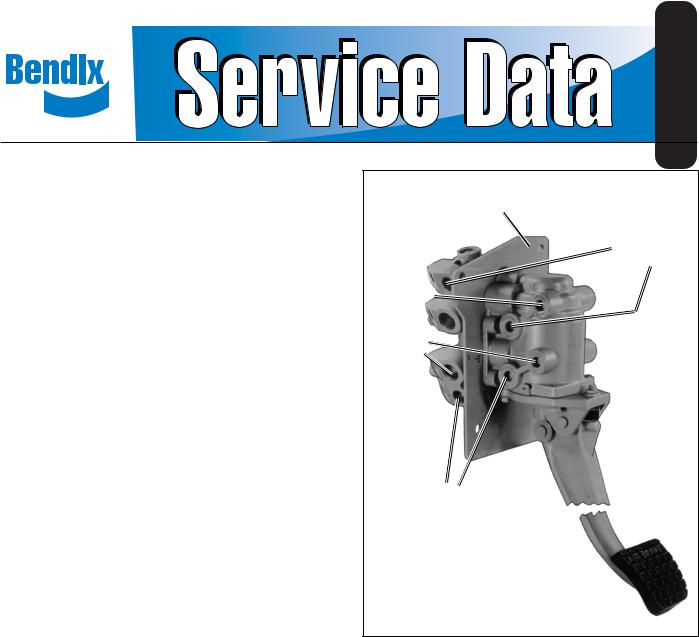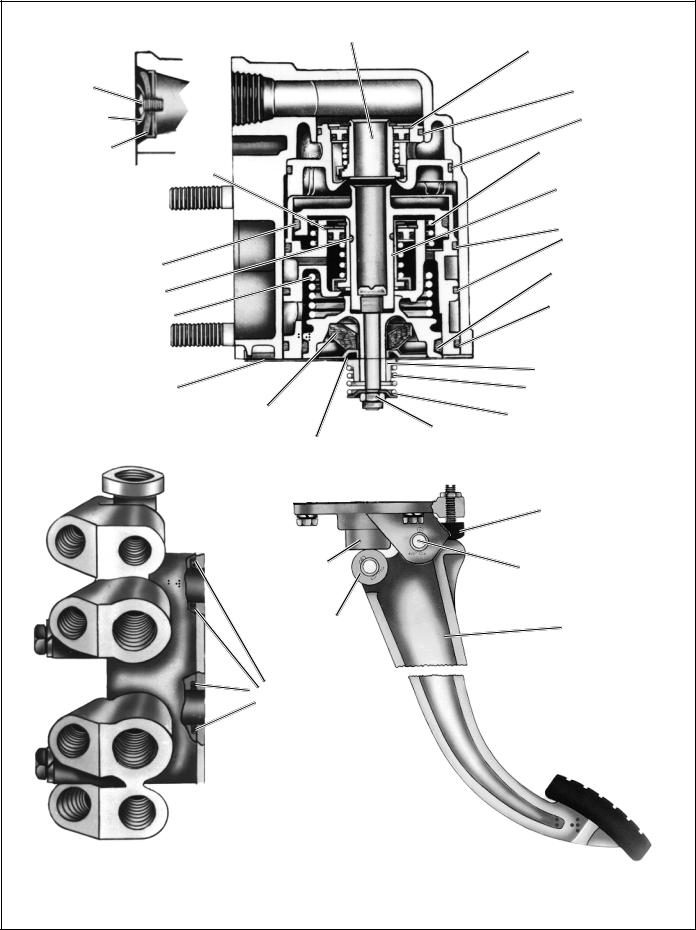Bendix E-7 DUAL BRAKE VALVE User Manual

®
Bendix® E-7™ Dual Brake Valve
DESCRIPTION
The Bendix® E-7™ dual brake valve is a suspended, pedal-operated type brake valve with two separate supply and delivery circuits for service and emergency braking, which provides the driver with a graduated control for applying and releasing the vehicle brakes.
The circuits in the E-7™ dual brake valve are identified as follows: The primary circuit portion is that portion of the valve between the spring seat which contacts the plunger and the relay piston; the secondary circuit portion is that portion between the relay piston and the exhaust cavity.
The primary circuit portion of the valve is similar in operation to a standard single-circuit air brake valve, and under normal operating conditions the secondary circuit portion is similar in operation to a relay valve.
The primary circuit portion of the valve is part of a removable cage which also houses the relay piston and the cage which can be removed without removing the entire brake valve.
Both primary and secondary circuit portions of the E-7™ dual brake valve use a common exhaust protected by an exhaust check valve.
OPERATION
APPLYING: NORMAL OPERATION - PRIMARY CIRCUIT PORTION
When the brake pedal is depressed, the plunger exerts force on the spring seat, rubber graduating spring, and primary piston. The primary piston which contains the exhaust valve seat, closes the primary exhaust valve. As the exhaust valve closes, the primary inlet valve is moved off its seat allowing primary air pressure to flow out the delivery port.
APPLYING: NORMAL OPERATION -
SECONDARY CIRCUIT PORTION
When the primary inlet valve is moved off its seat, air is permitted to pass through the bleed passage and enters the relay cavity. The air pressure moves the relay piston, and the relay piston, which contains the exhaust seat, closes the secondary exhaust valve. As the secondary exhaust
SD-03-818
MOUNTING
PLATE
SECONDARY
DELIVERY
SECONDARY
SUPPLY 
PRIMARY
SUPPLY
PRIMARY
DELIVERY
FIGURE 1 - E-7™ DUAL BRAKE VALVE
valve closes, the secondary inlet valve is moved off its seat allowing secondary air pressure to flow out the delivery port. Because of the small volume of air required to move the relay piston, action of the secondary circuit portion of the valve is almost simultaneous with the primary circuit portion.
APPLYING: LOSS OF AIR IN SECONDARY CIRCUIT
Should air be lost in the secondary circuit, the primary circuit portion will continue to function as described above under Normal Operation: Primary Circuit Portion.
1
APPLYING: LOSS OF AIR IN PRIMARY CIRCUIT
Should air be lost in the primary circuit, the function will be as follows: As the brake pedal is depressed and no air pressure is present in the primary circuit supply and delivery ports, the primary piston will mechanically move the relay piston allowing the piston to close the secondary exhaust valve and open the secondary inlet valve and allow air pressure to flow out the delivery port.
BALANCED: PRIMARY CIRCUIT PORTION
When air pressure delivered to the brake actuators and air pressure in the cavity on the delivery side of the primary piston equals the mechanical force of the brake pedal application, the primary piston will move and the primary inlet valve will close, stopping the further flow of air from the primary supply line through the valve. The exhaust valve remains closed preventing any escape of air through the exhaust port.
BALANCED: SECONDARY CIRCUIT PORTION
When the air pressure on the secondary side of the relay piston approaches that being delivered on the primary side of the relay piston, the relay piston moves closing the secondary inlet valve and stopping further flow of air pressure from the supply line through the valve. The exhaust remains closed as the pressures balance.
When applications in the graduating range are made, a balanced position in the primary portion is reached as the air pressure on the delivery side of the primary piston equals the effort exerted by the driver’s foot on the pedal. A balanced position in the secondary portion is reached when air pressure on the secondary side of the relay piston closely approaches the air pressure on the primary side of the relay piston.
When the brake pedal is fully depressed, both primary and secondary inlet valves remain open and full reservoir pressure is delivered out the delivery ports.
RELEASING: PRIMARY CIRCUIT PORTION
With the brake pedal released, mechanical force is removed from the spring seat, rubber graduating spring, and primary piston. Air pressure and spring load moves the primary piston, opening the primary exhaust valve allowing air pressure in the primary delivery line to exhaust out the exhaust port.
RELEASING: SECONDARY CIRCUIT PORTION
With the brake pedal released, air is exhausted from the primary side of the relay piston. Air pressure and spring load move the relay piston, opening the secondary exhaust valve allowing air pressure in the secondary delivery line to exhaust out the exhaust port.
PREVENTIVE MAINTENANCE
Important: Review the Bendix Warranty Policy before performing any intrusive maintenance procedures.Awarranty may be voided if intrusive maintenance is performed during the warranty period.
No two vehicles operate under identical conditions, as a result, maintenance intervals may vary. Experience is a valuable guide in determining the best maintenance interval for air brake system components. At a minimum, the E-7™ valve should be inspected every 6 months or 1500 operating hours, whichever comes first, for proper operation. Should the E-7™ valve not meet the elements of the operational tests noted in this document, further investigation and service of the valve may be required.
Every 3 months, 25,000 miles, or 900 operating hours:
Lubricate fulcrum and roller pin with Barium grease per BW-204-M (Bendix part 246671).
Free pedal travel should be checked as follows: Check to be certain plunger is in contact with spring seat. The stop button should be adjusted so that the roller and plunger just contact.
Apply a thin layer of Barium grease, per BW-204-M (Bendix part 246671), between plunger and mounting plate – do not over oil!
Clean exhaust check depending on type of service.
SERVICE CHECKS
OPERATING
Check the delivery pressure of both primary and secondary circuits using test gauges known to be accurate. Depress the pedal to several positions between the fully released and fully applied positions, and check the delivered pressure on the test gauges to see that it varies proportionately with the movement of the brake pedal.
When the treadle is fully applied, the reading on the test gauge should fall off to zero promptly when the application is released. It should be noted that the primary circuit delivery pressure will be about 2 psi greater than secondary circuit delivery pressure with primary and secondary circuit supply reservoirs at the same pressure. This is normal in this valve.
IMPORTANT
An increase in stopping distance or a low pressure warning indicates a malfunction in one or the other brake circuit, and although the vehicle air brake system may continue to function, the vehicle should not be operated until the necessary repairs have been made and both braking circuits are operating normally.
2

EXHAUST CHECK |
INLET-EXHAUST |
|
ASSEMBLY (1) |
|
|
VALVE |
|
|
|
RETAINER (17) |
|
|
|
|
SCREW (21) |
|
O-RING (2) |
|
|
|
WASHER (22) |
|
O-RING (3) |
DIAPHRAGM (13) |
|
RELAY SPRING (5) |
RETAINER (20) |
|
INLET-EXHAUST |
|
|
|
|
|
ASSEMBLY (4) |
|
|
O-RING (11) |
O-RING (7) |
|
O-RING (9) |
O-RING (6) |
|
O-RING (12) |
|
|
|
PISTON SPRING (8) |
|
|
|
|
SPRING SEAT NUT (16) |
RETAINER (18) |
|
STEM SPRING (23) |
RUBBER SPRING (10) |
|
SPRING SEAT (15) |
RUBBER SPRING SEAT (19) |
LOCK NUT (14) |
|
|
||
|
STOP BUTTON |
PLUNGER |
FULCRUM PIN |
ROLLER |
PEDAL |
SEALING
RINGS
MANIFOLD*
*OPTIONAL MANIFOLD FOR INSTALLATIONS REQUIRING SUPPLY & DELIVERY LINE CONNECTIONS ON ENGINE SIDE OF ENGINE COMPARTMENT BULKHEAD.
FIGURE 2 - E-7™ DUAL BRAKE VALVE
3
